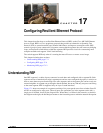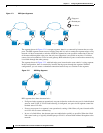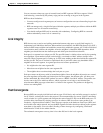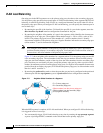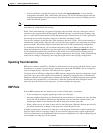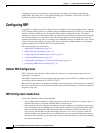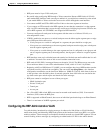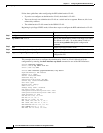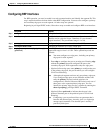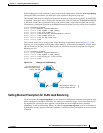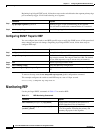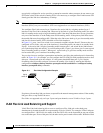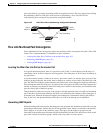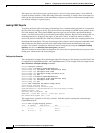
17-9
Cisco ME 3400 Ethernet Access Switch Software Configuration Guide
OL-9639-06
Chapter 17 Configuring Resilient Ethernet Protocol
Configuring REP
Configuring REP Interfaces
For REP operation, you need to enable it on each segment interface and identify the segment ID. This
step is required and must be done before other REP configuration. You must also configure a primary
and secondary edge port on each segment. All other steps are optional.
Beginning in privileged EXEC mode, follow these steps to enable and configure REP on an interface:
Command Purpose
Step 1
configure terminal Enter global configuration mode.
Step 2
interface interface-id Specify the interface, and enter interface configuration mode. The
interface can be a physical Layer 2 interface or a port channel
(logical interface). The port-channel range is 1 to 48.
Step 3
port-type nni Configure the port as a network node interface (NNI).
Step 4
switchport mode trunk Configure the interface as a Layer 2 trunk port.
Step 5
rep segment segment-id [edge [primary]]
[preferred]
Enable REP on the interface, and identify a segment number. The
segment ID range is from 1 to 1024. These optional keywords are
available.
Note You must configure two edge ports, including one primary
edge port for each segment.
• Enter edge to configure the port as an edge port. Entering edge
without the primary keyword configures the port as the
secondary edge port. Each segment has only two edge ports.
• (Optional) On an edge port, enter primary to configure the port
as the primary edge port, the port on which you can configure
VLAN load balancing.
Note Although each segment can have only one primary edge port,
if you configure edge ports on two different switches and
enter the primary keyword on both switches, the
configuration is allowed. However, REP selects only one of
these ports as the segment primary edge port. You can
identify the primary edge port for a segment by entering the
show rep topology privileged EXEC command.
• (Optional) Enter preferred to indicate that the port is the
preferred alternate port or the preferred port for VLAN load
balancing.
Note Configuring a port as preferred does not guarantee that it
becomes the alternate port; it merely gives it a slight edge
among equal contenders. The alternate port is usually a
previously failed port.



